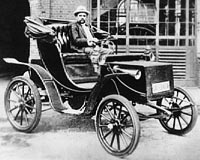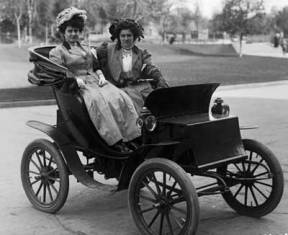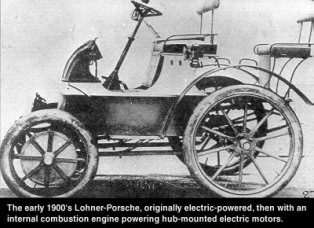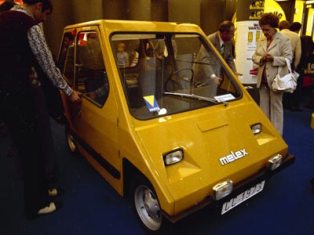Stages of development of electric vehicles and their construction
 The analysis of works on the creation of electric vehicles abroad and in our country, starting from the moment of their origin and including the present day, shows that it is possible to distinguish conditionally five periods of their development:
The analysis of works on the creation of electric vehicles abroad and in our country, starting from the moment of their origin and including the present day, shows that it is possible to distinguish conditionally five periods of their development:
The first - the birth (1837-1895 gg.);
-
The second - intensive development and competition (1896 - 1930 gg.);
Third - local use (1931-1960 gg.);
The fourth - the extensive conduct of development work and the production of a large number of prototypes and small series of experimental electric vehicles (1961-1982);
The fifth - a certain decline in work caused by a sharp change in the oil market conditions and the failure to operate pilot batches because of the shortage of current sources (after 1982).
To the harbingers of electric cars, characterizing the first stage of their development, one can include the crews created in 1837 by Americans by Deventerator and Page, and also by Scot Robert Davidson.
In 1838 in Russia experiments with an engine powered by a battery of galvanic cells were conducted by BS Jacobi.
Since 1880, the development of electric vehicles has occurred in parallel with the car. In those years, cars with ICE were not yet a serious competitor to electric vehicles. This was due to the fact that the design of electric vehicles was simpler and they (like cars) were used only in cities and carried out movement within a radius of 10-15 km. The speed of such vehicles did not exceed 20 km / h.

The second stage is characterized by considerable competition in the field of creating cars, the production of which has increased significantly. In this period, electric vehicles are being produced serially. So, in 1897 on the streets of London appeared and successfully operated electric taxi cars, apparently little different from traditional English cabs. In 1906, A. Verdein in France organized a mass production of passenger electric vehicles with a power reserve of up to 80 km and a maximum speed of 30 km / h.
In 1899 the first Russian electric vehicles, created by engineer IV Romanov, appeared, and in 1901 the first 15-seat electric bus was built by him.

By the end of the last century, electric vehicles had set a number of speed records. So, in 1898 the electric car reached a speed of 63.3 km / h. A year later at the competitions organized by the Paris Autoclub, he had a speed of 106 km / h.
By the beginning of the 20th century, 38% of the total number of US cars had electric engines, 40% - steam engines, 22% - gasoline.
For the first decade of this period, the rise in the development and production of electric vehicles is characteristic, and then some decline. During this period, the mass production of electric vehicles was organized in England, Germany, the USA, France, Japan and other countries. Thus, in 1912, 6,000 cars and 4,000 electric trucks were produced in the USA. Electric vehicles had an average power reserve of 50-80 km, and a speed of 20-35 km / h. At the same time, it should be noted that the cargo electric vehicles had a relatively high load capacity, which sometimes exceeded 6 tons, and the energy costs for transportation were rather small - 0.054-0.095 kWh per 1 ton-km of the full transport work of the electric vehicle.

In the years 1918-1928. Simplified designs of electric vehicles in the form of electric trucks have found wide application as a technological transport in engineering enterprises.
Already in the first decades of the twentieth century, the competitiveness of a car in relation to an electric vehicle has increased. This is explained by the further improvement of the design of piston engines, which provided the cars with speeds exceeding 80 km / h, and a fuel reserve of up to 300 km. This allowed us to use the car outside the city.
The organization of mass production of cars with ICE and a low cost of fuel at high technical and operational parameters made the car unattainable for an electric vehicle.
The third period is characterized by the fact that already in the early 30-ies of the XX century, the production of electric vehicles was sharply reduced. Only in individual countries, such as the United Kingdom. Germany and the United States, continued their production in small batches. Electric cars were used for transportation, where small runs and low speeds were required. In 1939, the number of electric vehicles in Germany was more than 9 thousand, and by 1944 reached 20 thousand units. The latter is explained by the German government's intention to reduce dependence on imported petroleum fuel.

In the third period, there is also an increase in the production of electric vehicles in England. So, from 1930 to the 1960s. Their number increased 15 times and reached 26 thousand units. At the same time, electric cars were effectively used in the process of centralized delivery to the house of various goods from the trading network, the transportation of parcels and mail, i.e., where large daily average travel reserves and high vehicle speeds were not required. During these same years in our country, work was periodically carried out to create experimental models of electric vehicles.
So, in 1935 on the basis of the GAZ-A car the first Soviet electric vehicle was built. At the same time in the laboratory of electric traction of the Moscow Power Engineering Institute under the leadership of prof. V.E. Rezenford and Ing. Yu. M. Galkin was created a two-ton electric car based on the ZIS-5.
In 1948, NAMI developed and manufactured electric vehicles with a carrying capacity of 0.5 and 1.5 tons, four samples of which were used to transport mail in Moscow. Then 10 prototypes of these electric vehicles, manufactured by the Lviv Bus Plant, were operated from 1952 to 1958. In Leningrad; They were also mainly used for the transport of mail cargo.
In 1957, NAMI developed new models of electric vehicles of the same lifting capacity, and two years later NAMI together with the Ulyanovsk Automobile Plant named after VI Lenin produced a prototype of an electric vehicle with a payload capacity of 0.8 t on the basis of the UAZ-450 car. In the same period, the first Soviet electric bus was built on the basis of the SVARZ trolleybus with a capacity of 70-80 people.
From what has been said above, it follows that in the period from 1930 to 1960, In our country there have been regular experimental studies on the development and use of electric vehicles in the national economy of the country, although they have not been widely used.
The fourth period, beginning in the mid-1960s, is characterized by a new heightened interest in electric vehicles in many industrialized countries.
Especially intensively they began to be developed in the USA, Japan, Germany and England, which is mainly due to the aggravation of energy and environmental problems.The energy crisis that arose in the late sixties and early seventies of the twentieth century in many capitalist countries showed that Resources of oil top-lines for cars with ICE on our planet are limited.
On the other hand, the high saturation of cities by road transport caused a sharp increase in the level of air pollution by exhaust gases of ICE. Taking into account that electric cars do not require liquid fuel and they practically do not create noise pollution and toxic emissions on highways and streets of cities, scientists and engineers have made an attempt with their help to help solve the environmental problem.

In this connection, in the period from 1966 to 1971, The greatest number of prototypes of electric vehicles was developed, although they were not usually found to be of further noticeable development and application. Often abroad such developments were of an advertising nature. The main reason for the stagnation in the development of modern electric vehicle designs was the lack of new current sources, which possess high energy intensity with little cost.
Despite these disadvantages of batteries, the production of electric vehicles (for example, in England) continues to grow.
Electric Vehicle: Technology and Economics / VA Shchetinina and others. Leningrad: 1987.


Comments
When commenting on, remember that the content and tone of your message can hurt the feelings of real people, show respect and tolerance to your interlocutors even if you do not share their opinion, your behavior in the conditions of freedom of expression and anonymity provided by the Internet, changes Not only virtual, but also the real world. All comments are hidden from the index, spam is controlled.